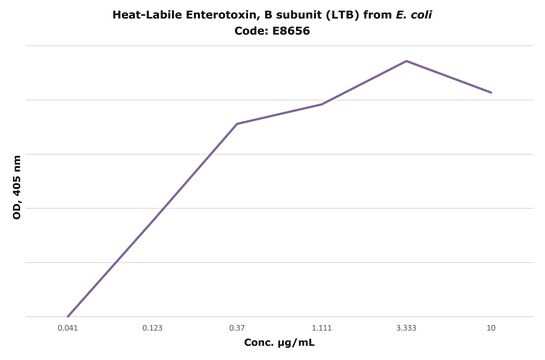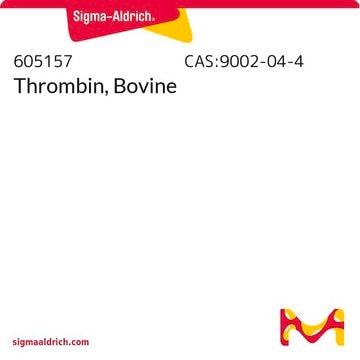E5763
Escherichia coli heat-stable enterotoxin STa
lyophilized powder, ~100,000 units/mg protein (HPLC)
Iniciar sesiónpara Ver la Fijación de precios por contrato y de la organización
About This Item
Número MDL:
Código UNSPSC:
12352200
Productos recomendados
formulario
lyophilized powder
actividad específica
~100,000 units/mg protein (HPLC)
mol peso
1,972 Da
solubilidad
aqueous buffer: ≥5 mg/mL (More soluble under acidic conditions)
temp. de almacenamiento
−20°C
Acciones bioquímicas o fisiológicas
STa has a tertiary structure, maintained by disulfide bridges, which is required for receptor binding and biological activity. Its receptors are membrane-bound guanylyl cyclases. These receptors are located on enterocytes, colonocytes, and various extraintestinal tissues. STa causes diarrhea in humans by binding to its receptor, stimulating the guanylyl cyclase, and triggering production of cyclic GMP. Endogenous ligands for the STa receptor include guanylin, extracted from intestine, and uroguanylin from urine. These peptides may have a role in the regulation of fluid and electrolytes. Protein kinase C (PKC) phosphorylates and activates the STa receptor/guanylyl cyclase in vitro and in vivo. As a result, stimulators of PKC synergistically enhance STa effects on cGMP and secretion.
Otras notas
E. coli STa is a heat-stable peptide toxin.
Definición de unidad
One unit is the amount of toxin which produces an intestinal weight/carcass weight ratio of ≥0.083 in 3-day-old mice.
Código de clase de almacenamiento
6.1A - Combustible acute toxic Cat. 1 and 2 / very toxic hazardous materials
Clase de riesgo para el agua (WGK)
WGK 3
Punto de inflamabilidad (°F)
Not applicable
Punto de inflamabilidad (°C)
Not applicable
Certificados de análisis (COA)
Busque Certificados de análisis (COA) introduciendo el número de lote del producto. Los números de lote se encuentran en la etiqueta del producto después de las palabras «Lot» o «Batch»
¿Ya tiene este producto?
Encuentre la documentación para los productos que ha comprado recientemente en la Biblioteca de documentos.
R N Greenberg et al.
Journal of investigative medicine : the official publication of the American Federation for Clinical Research, 45(5), 276-282 (1997-06-01)
Uroguanylin and guanylin are intestinal peptides that activate a receptor-guanylate cyclase, which is also a receptor for Escherichia coli heat-stable enterotoxin (STa). These peptides may have a role in the body's regulation of fluid and electrolytes. STa, bioactive guanylin, and
R A Giannella
The Journal of laboratory and clinical medicine, 125(2), 173-181 (1995-02-01)
STa represents a family of homologous heat-stable peptide toxins that are elaborated by a variety of bacteria capable of causing enteric disease in human beings. All these peptides have a tertiary structure, maintained by disulfide bridges, which is required for
J K Crane et al.
Molecular and cellular biochemistry, 165(2), 111-120 (1996-12-20)
The heat-stable enterotoxin STa of E. coli causes diarrhea by binding to and stimulating intestinal membrane-bound guanylyl cyclase, triggering production of cyclic GMP. Agents which stimulate protein kinase C (PKC), including phorbol esters, synergistically enhance STa effects on cGMP and
S P Range et al.
British journal of pharmacology, 120(7), 1249-1254 (1997-04-01)
1. Guanosine 3':5'-cyclic monophosphate (cyclic GMP) is an important second messenger mediating the effects of nitric oxide (NO) and natriuretic peptides. Cyclic GMP pathways regulate several aspects of lung pathophysiology in a number of airway cells. The regulation of this
A M Al-Majali et al.
Journal of immunological methods, 222(1-2), 65-72 (1999-02-18)
Binding of Escherichia coli heat-stable enterotoxin (STa) to its putative receptor on the brush border membrane of enterocytes is a prerequisite for the induction of diarrhea in infected humans and animals. Humans and animals of different ages vary in their
Nuestro equipo de científicos tiene experiencia en todas las áreas de investigación: Ciencias de la vida, Ciencia de los materiales, Síntesis química, Cromatografía, Analítica y muchas otras.
Póngase en contacto con el Servicio técnico








